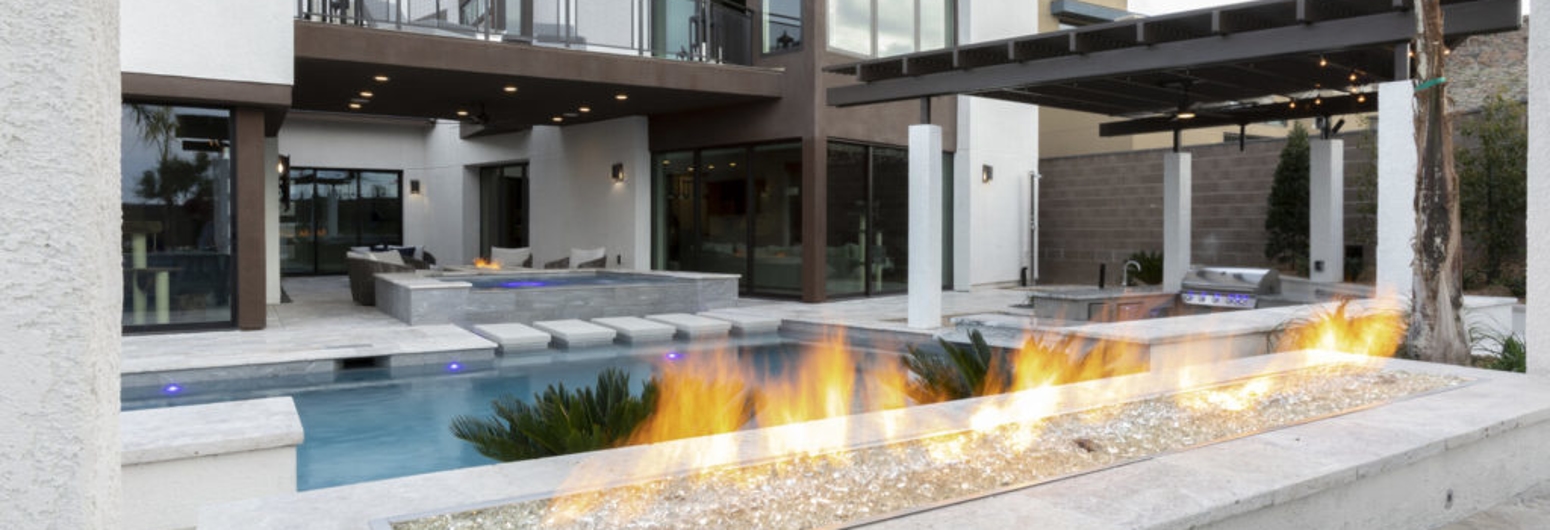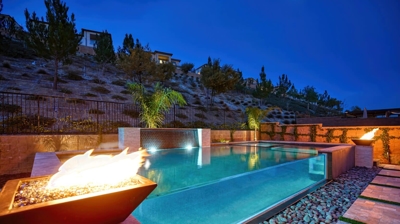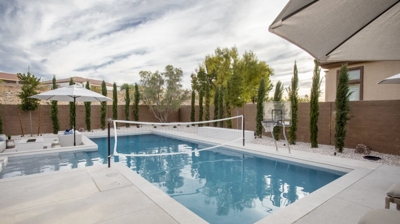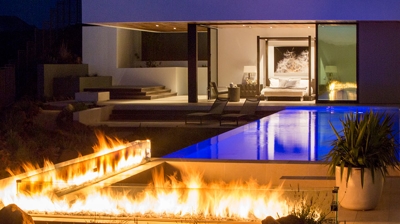With over 71% of American workers working remotely due to the COVID-19 pandemic, people spend more time at home than ever before. It’s a no-brainer, therefore, that homeowners are looking for new ways to extend house spaces to the outdoors. Among the most desired features is a floating fire pit in a pool.
The general perception is that fire and water cannot co-exist. However, when it comes to pool fire features, swimming pool builders will tell you that this assertion isn’t entirely accurate. Fire and water can mix and coexist.
And usually, when they do, you get the best of both worlds. Read on for a detailed guide on using fire pits and other pool fire features to enhance your outdoor space’s sophistication and appearance.
How Do Swimming Pools and Fire Pits Work?
While a floating fire pit for your pool may sound as easy as buying one on Amazon, floating bowls aren’t always best, as water splashing, waves, rain, and other issues can hamper their use. Instead of a floating fire pit in your pool, consider one that’s built into your pool structure or surrounding area. These will last longer and present fewer usage and maintenance issues in the long run.
Related: Which Water and Fire Features for Swimming Pools Are Trending?
Most pool fire features have lava stones, smooth river rocks, or colorful iridescent fire glass covering a burner to bring an extra dimension of aesthetic appeal. Typically, gas powers the flames. In some instances, you can use propane instead. A fuel line, usually buried in the ground under the deck, runs to a burner inside the feature. Alternatively, you can manually light the pot or pit.
A better way to light the pit is by using an electronic igniter. However, this method will require the installation of a power line—at an additional cost. The trade-off is that you’ll be able to remotely ignite the flames.
Fire pits and pots are available in several forms and designs, and all add exquisite looks to your outdoor environment. Which of the two do you think will be the most enticing for your new aquatic retreat?
In this article, we delve into both fire pits and fire bowls and how to integrate them into your pool project.
Use Fire Bowls To Give Your Pool An Extra Taste Of Class And Elegance
When it comes to floating fire pits for your pool, a fire bowl is one of the most popular pool fire features. These small, prefabricated jars in round or square shapes are perfect for lighting up your backyard pool at night. Some fire bowls have the form of a Chinese cooking wok, hence the name “fire-woks.”
Fire pots are typically two to three feet in diameter and 12 to 24 inches tall. They have a burner mechanism inside that connects to a natural gas (or propane) line. Some models are multifunctional to add additional drama: while flames shoot into the air, the bowls—with adequate plumbing—spout a smooth cascade of water into the pool surface below.
The variety of available types is another factor that makes fire bowls popular among pool customers. Copper and colored concrete are the most common finishes, but stainless steel is also available. You can choose your preferred—ranging from rustic to modern—finish to complement your pool types. Even when you turn the flames off, the bowls act as decorative features around the pool.
Related: Backyard Renovation with Pool Reinvention
Pool designers typically include one or more bowls on a structural perch along and above the pool’s perimeter. Instead of a floating fire pit in your pool, these often stand on a raised bond beam forming part of the pool wall.
These bond beam structures usually form a platform to exhibit the bowls and elevate their flames for better viewing from afar. You can also place small fire bowls in niches on some designs of massive rock waterfalls.
Use Decorative Fire Pits To Add Integrated Beauty
A decorative fire pit has an exterior typically composed of stones or tiles, or both. Most designers like using facing materials with the same color as tiles or stones used in the pool’s deck or center copying. Some builders use tiles. This harmonized palette contributes to an aesthetically pleasing backyard area.
The majority of pool fire pits are circular, but others are square or rectangular. Builders place the fire pit on a patio area at least several feet away from the pool. In most cases, you can place seats for four to six people around the open, free-standing structure.
While the majority use gas, other pits may also burn wood. This type of fire pit warms the backyard setting and contributes to creating a cozy conversation place.
A decorative pool fire pit, like the patio version, is now a custom concrete structure covered in harmonizing stone. The design differs in how it is built directly into the pool, which you can do during the gunite/shotcrete process.
Instead of a free-standing structure, you’ll have a decorative feature that completely integrates into the pool’s perimeter wall. In other words, the pit forms an integral component of the swimming pool.
Keep in mind that builders usually design this type of fire to be aesthetically pleasing rather than functional. In many situations, the arrangement will not allow for nearby seating as conveniently as a patio fire pit; however, some will have an open area around half the diameter where you can pull up two chairs. In some installations, the pool construction includes handy built-in seating near the fire pit, usually along the same raised wall.
More Elaborate Pool Fire Features
For pool customers with large project budgets, highly customized fire bowls and fire pits are also available. Pool builders, for example, can install glass-enclosed fireboxes along the pool’s edge. This style works well with modern pools and garden settings.
Another alternative is to build straight or curved raised pool walls with fire-recessed niches. With this method, you can create a “wall of fire” to serve as a backdrop for a spa or a specialized seating area within a pool.
Another v complex—and expensive—option is a “floating” fire pit or fire bowl inside the pool for a jaw-dropping effect. Unlike a floating fire pit you may buy online for your pool, this version is professionally anchored to the pool floor or built as a peninsula tied to a feature like a sizable sunbathing ledge. In each case, a concrete base supports the pit. As a result, the fire pit appears to be floating on water.
You can use a similar concept to create an incredible fire bowl installation by placing a bowl further out in the pool’s interior. As a result, because it “sits” on the pool’s surface, it will appear more buoyant in the water.
Do you have further queries or need assistance integrating a fire pit into your swimming pool? Get in touch with California Pools or visit our website to Book a Virtual Meeting.



